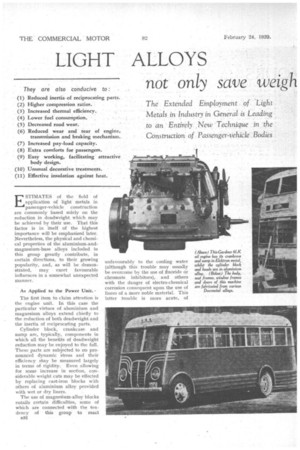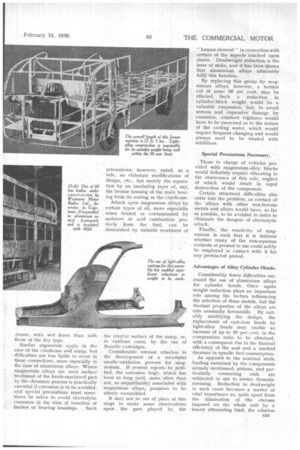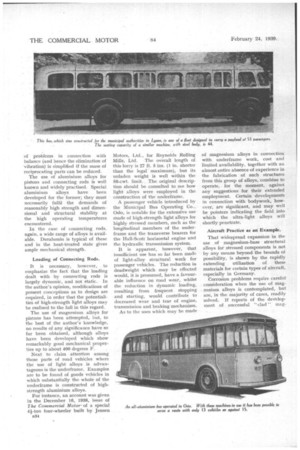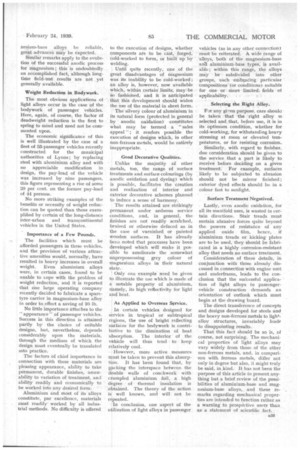LIGHT ALLOYS
Page 74

Page 75

Page 76

Page 77

If you've noticed an error in this article please click here to report it so we can fix it.
not only save weigh
• The Extended Employment of Light, Metals in Industry in General is Leading to an Entirely New Technique in Ithe Construction of Passenger-vehicle Bodies ESTIMATES of the field of application of light metals in passenger-vehicle construction are commonly based solely on the reduction in deadweight which may be achieved by their use. That this factor is in itself of the highest importance will be emphasized later. Nevertheless, the physical and chemical properties of the aluminium-andmagnesium-base alloys included in this group greatly contribute, in certain directions, to their growing popularity, and, as will be demonstrated, may exert favourable influences in a somewhat unexpected manner.
As Applied to the Power Unit.'
The first item to claim attention is the engine unit. In this case the particular virtues of aluminium and magnesium alloys extend chiefly to the reduction of both deadweight and the inertia of reciprocating parts.
Cylinder block, crankcase and sump are, typically, components in which all the benefits of deadweight reduction may be enjoyed to the full. These parts are subjected to no pronounced dynamic stress and their efficiency 'nay be measured largely in terms of rigidity. Even allowing for some increase in section, considerable weight cuts may be effected by replacing cast-iron blocks with others of aluminium alloy provided with wet or dry liners.
The use of magneSium-alloy blocks entails certain difficulties, some of which are connected with the tendency of this group to react
B32 unfavourably to the cooling water (although this trouble may usually be overcome by the use of fluoride or chromate inhibitors), and others with the danger of electro-chemical corrosion consequent upon the use of liners of a more noble material. This latter trouble ig more acute, of course, with wet liners than with those of the dry type.
Similar arguments apply in the case of the crankcase and sump, but difficulties are less liable to occur in these connections, more especially in the case of aluminium alloys. Where magnesium alloys are used surface treatment of the finish-machined part by the chromate process is practically essential if corrosion is to be avoided, and special precautions must sometimes be taken to avoid electrolytic corrosion at the sites of insertion of bushes or bearing .housings. Such precautions, however, entail, as a rule, no elaborate modifications of design, etc., but merely the separation by an insulating layer of, say, the bronze housing of the main bearing from its seating in the crankcase.
Attack upon magnesium alloys by certain types of oil, snore especially when heated or contaminated by moisture or acid combustion products from the fuel, can be diminished by suitable treatment of the interior surface of the sump, or, in extreme cases, by the use of fluoride cartridges.
Considerable interest attaches to the development of a successful anodic-oxidation process for magnesium. If present reports be justified, the corrosion bogy, which has been so long (and, more often than not, so unjustifiably) associated with magnesium alloys, promises to be utterly vanquished.
It may not be ant of place at this stage to make some observations upon the part played by the "human element" in connection with certain of the aspects touched upon above. Deadweight reduction is the issue at stake, and it has been shown that aluminium alloys admirably fulfil this function.
By replacing this group by magnesium alloys, however, a further cut of some 30 per cent. may be effected. Such a reduction in cylinder-block weight would be a valuable concession, but, to avoid serious and expensive damage by corrosion, constant vigilance would have to be exercised as to the nature of the cooling water, which would require frequent changing and would always need to be treated with inhibitors.
Special Precautions Necessary.
Those in charge of vehicles provided with magnesium-alloy blocks would definitely require educating to the observance of this rule, neglect of which would tesult in rapid destruction of the component.
Certain structural difficulties also enter into the problem, as contact of the alloys with other non-ferrous metals and alloys would have, so far as possible, to be avoided in order to eliminate the dangers of electrolytic attack.
Finally, the reactivity of magnesium is such that it is dubious whether many of the non-aqueous coolants at present in use could safely be employed in contact with it for any protracted period.
Advantages of Alloy Cylinder Heads.
Considerably fewer difficulties surround the use of aluminium alloys for cylinder heads. Once again weight reduction plays an important role among the factors influencing the selection of these metals, but the thermal properties of the alloys are also unusually favourable. By suitably modifying the design, the replacement of cast-iron heads by light-alloy heads may enable an increase of up to 20 per cent. in the compression ratio to be obtained, with a consequent rise in the thermal efficiency of the unit and a marked decrease in specific fuel consumption.
As opposed to the nominal static loading sustained by the components already mentioned, pistons, and particularly connecting rods. are subjected in use to severe dynamic stressing. Reduction in deadweight in such cases becomes a matter of vital importance as, quite apart from the elimination of the stresses imposed on the whole unit by a .heavy alternating Idad, the solution of problems in connection with balance (and hence the elimination of vibration). is simplified if the mass of reciprocating parts can be reduced.
The use of aluminium alloys for pistons and connecting rods is well known and widely practised. Special aluminium alloys have been developed for the former; they must necessarily fulfil the demands of reasonably high strength and dimensional and structural stability at the high operating temperatures encountered.
In the case of connecting rods, again, a wide range of alloys is available. Duralumin is typical of these and in the heat-treated state gives ample mechanical strength.
Loading of Connecting Rods.
It is necessary, however, to emphasize the fact that the loading dealt with by connecting rods is largely dynamic, and not static. In the author's opinion, modifications of present conceptions as to design are required, in order that the potentialities of high-strength light alloys may be realized to the full in this regard.
The use of magnesium alloys for pistons has been attempted, but, to the best of the author's knowledge, no results of any significance have so far been obtained, although alloys have been developed which show remarkably good mechanical properties up to about 400 degrees F.
Next to claim attention among those parts of road vehicles where the use of light alloys is advantageous is the underframe. Examples are to be found of goods vehicles in which substantially the whole of the underframe is constructed of highstrength aluminium alloys.
For instance, an account was given in the December 16, 1938, issue of The Commercial Motorof a special 4i-ton four-wheeler built by Jensen
B34
Motors, Ltd., for Reynolds Rolling Mills, Ltd. The overall length of this lorry is 27 ft. 5 ins. (1 in. shorter than the legalmaximum), but its unladen weight is well within the 50-cwt. limit. The original description should be consulted to see how light alloys were employed in the construction of the underframe.
A passenger vehicle introduced by the Municipal Bus Operating Co-, Oslo, is notable for the extensive use made of high-strength light alloys for highly stressed members, such as the longitudinal members of the underframe and the transverse bearers for the Hall-Scott horizontal engine and the hydraulic transmission system.
• It is apparent, however, that insufficient use has so far been made of light-alloy structural work for passenger vehicles. The reduction in deadweight which may be effected would, it is presumed, have a favourable influence on road wear, whilst the reduction in dynamic loading, resulting from frequent stopping and starting, would contribute to decreased wear and tear of engine, transmission and braking mechanism.
As to the uses which may be made of magnesium alloys in connection with underframe work, cost and limited availability, together with an almost entire absence of experience in the fabrication of such structures from this group of alloys, combine to operate, for the moment, against any suggestions for their extended employment. Certain developments in connection with bodywork, however, are significant, and may well be pointers indicating the field into which the ultra-light alloys will shortly penetrate.
Aircraft Practice as an Example.
That widespread expansion in the use of magnesium-base structural alloys for stressed components is not by any means beyond the bounds of possibility, is shown by the rapidly extending utilization of these materials for certain types of aircraft, especially in Germany.
Corrosion problems require careful consideration when the use of magnesium alloys is contemplated, but are, in the majority of cases, readily solved. If reports of the deVelopment of successful " clad " mag nesium-base alloys be reliable, great •advances may be expected.
Similar remarks apply to the evolution of the successful anodic process for magnesium ; this is undoubtedly an accomplished fact, although longtime field-test results are not yet generally available.
Weight Reduction in Bodywork.
The most obvious applications of light alloys occur in the case of the bodywork of passenger vehicles. Here, again, of course, the factor of deadweight reduction is the first to spring to mind and need not be commented upon.
The economic significance of this is well illustrated by the case of a fleet of 53-passenger vehicles recently constructed for the municipal authorities of Lyons ; by replacing steel with aluminium alloy and with no appreciable modification in design, the pay-load of the vehicle was increased by nine passengers, this figure representing a rise of some 20 per cent, on the former pay-load of 44 persons.
No more striking examples of the benefits or necessity of weight reduction can be quoted than those exemplified by certain of the long-distance inter-urban and transcontinental vehicles in the United States, Importance of a Few Pounds.
The facilities which must be afforded passengers in these vehicles, and the provision of various attractive amenities would, normally, have resulted in heavy increases in overall weight. Even aluminium alloys were, in certain cases, found to be unable to cope with the problem of weight reduction, and it is reported that eine large operating company recently decided to fabricate a sparetyre carrier in magnesium-base alloy in order to effect a saving of 10 lb.
No little importance attaches to the " appearance" of passenger vehicles, Success in this direction is attained partly by the choice of suitable designs, but, nevertheless, depends considerably upon the materials, through the medium of which the design must eventually be translated into practice.
The factors Of chief importance in connection with these materials are pleasing appearance, ability to take permanent, durable finishes, amenability to variation of treatment, and ability readily and economically to be worked into any desired form.
Aluminium and most of its alloys constitute, par excellence, materials most readily worked by all industrial methods. No difficulty is offered to the execution of designs, whether components are to be cast, forged, cold-worked to form, or built up by welding.
Until quite recently, one of the great disadvantages of magnesium was its inability to be cold-worked; an alloy is, however, now available which, within certainlimits; may be so fashioned, and it is anticipated that this development should widen the use of the material in sheet form.
The silvery colour of aluminium in its natural form (protected in general by anodic oxidation) constitutes what may be termed a "sales appeal " ; it renders possible the execution of designs which, in other non-ferrous metals, would be entirely inappropriate.
Good Decorative Qualities.
Unlike the majority of other metals, top, the range of surface treatments and surface colourings (by anodic oxidation and dyeing) which is possible, facititates the creation and realization of interior and exterior decorative schemes planned to induce a sense of harmony.
The results attained are strikingly permanent under arduous service conditions, and, in general, the finishes are not readily scratched, bruised or otherwise defaced as in the case of varnished or painted Wooden surfaces. It has already beea noted that processes have been developed which will Make it possible to ameliorate the somewhat unprepossessing grey colour of magnesium alloys in their natural state..
' Only one example need be given to illustrate the use which is made of a notable property of aluminium, namely, its high• reflectivity for light and heat.
As Applied to Overseas Service.
In certain vehicles designed for service in tropical or subtropical regions, the use of bright reflecting surfaces for the bodywork is contributive to the diminution of heat absorption. The interior of the vehicle will thus tend to keep relatively cool.
However, more active measures must be taken to prevent this absorption. It has been found that, by Racking the interspace between the double walls of coachwork with crumpled aluminium foil, a high degree of thermal insulation is ..obtained. The theory of the action is well known, and will not be repeated.
In conclusion, one aspect of the utilization of light alloys in passenger vehicles (as in any other connection) 'must be reiterated. A wide range of
• -alloys, both of the magnesium-base an aluminium-base types, is avaih able; within this range, the alloys may • be subdivided into other
• groups, each • embracing particular compositions (or conditions) suitable for one or . more limited, fields at • applicability.
• Selecting the Right Alloy.
. For any given purpose, care should be taken -that the right alloy is selected and that, before use, it is in its optimum condition, whether for cold-working, for withstanding heavy stressing at room or elevated temperatures, or for resisting corrosion.
Similarly, with regard to finishes, due consideration should be given to the service that a part is likely to receive before deciding on a given treatment. For example, surfaces likely to be subjected to abrasion should not be mirror finished ; exterior dyed effects should be in a colour fast to sunlight.
Surface Treatment Negatived.
Lastly, even anodic oxidation, for all its manifold uses, is wasted in certain directions. Stair treads mist sustain abrasive forces quite beyond the powers of resistance of any applied oxide film, hence, if aluminium treads or kicking plates are to be used, they should be fabricated in a highly corrosion-resistant alloy that needs no surface treatment.
Consideration of these details, in conjunction with those already discussed in connection with engine unit and underframe, leads to the conclusion that the successful application of light alloys to passengervehicle construction demands an orientation of outlook which must begin at the drawing board.
The direct transference of concepts and designs developed for steels and the heavy non-ferrous metals to light.alloy structures, invariably lead to disappointing results.
That this fact should be so is, of course, not surprising. The mechanical properties of light alloys may vary widely from those of the other non-ferrous metals, and, in comparison with ferrous metals, differ not only in degree but also, it might truly be said, in kind. It has not been the purpose of this article to present anything but a brief review of the possibilities of aluminium-base and magnesium-base alloys, and these remarks regarding mechanical properties are intended to function rather as a warning to prospective users' than as a statement of scientific fact.












































































































































